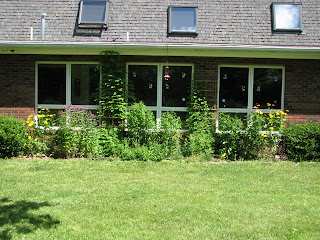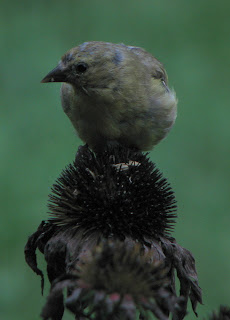Really, nothing beats positive payback. Two years ago we started a two-pronged attack to improve our four acres of land. We started a concerted effort to remove exotic and invasive plants and we started to landscape our yard with natives. Our first improvement was ripping out a pair of yuccas and a couple of hostas that lined the side of our house. The tall windows from the family room overlooked these plants, and while vaguely nice looking, they weren't very attractive.
We replaced them with several species of native plants. American Beauties is a pretty nice line of plants, specifically promoting native species, and for our side garden we specifically targeted:
- Trumpet Creeper (Lonicera sempervirens)
- Bee Balm (Mondarda didyma)
- Purple Coneflower (Echinacea purpurea)
- Butterfly Weed (Asclepias tuberosa)
- Brown-eyed Susan (Rudbeckia triloba)
- Wild Columbine (Aquilegia canadensis)
- Labrador Violet (Viola labradorica)
Anyway, from earlier this summer:
 The native wildflowers we planted last year came in pretty thick
The native wildflowers we planted last year came in pretty thickthis year, and a bit taller than we expected. We may relocate
some of the taller species and replace them with shorter ones.
© Mike Powers 2007
All summer long we had a front-row seat while Ruby-throated Hummingbirds, various butterflies, and other insects probed the flowers for nectar.
Now that it's November the flowers, of course, are long dead, but the seeds have set and are ripe for the picking. We can stand in our family room and watch seed eaters pick through these seed heads.
In October we saw the first bird visit our native wildflowers. Unlike chickadees, the finches will sit all day and thoroughly exhaust a seed bank if they feel safe. As long as we move slowly, we can get right up to the windows to watch.
Not much action took place for a couple of weeks, but this weekend we had another encounter with goldfinches and coneflowers. We had to be content with a backside view.
While working the seed hull to get to the meat, though, she was checking out all around her.
Dark-eyed Juncos are now back in numbers. We don't see them often in the summer months, though we do have a couple that breed on our hill. In earlier winters they've often used this "side garden," presumably only for cover. Now it seems for both cover and food.
This female is showing some bluish sheen in some feathers, looks kind of Indigo Bunting like. Real, or trick of the light?
Hopefully we'll get many more visits from a diversity of species.Post title credit: Don't Fear the Reaper (1976), Blue Oyster Cult








No comments:
Post a Comment